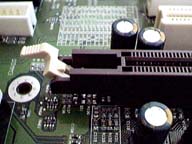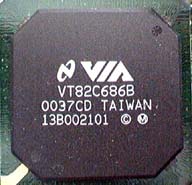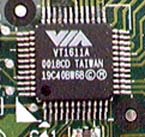EPoX EP-8KTA2 Socket-A KT133 (686B) ATX
by Henry Kuo on November 14, 2000 12:00 PM EST- Posted in
- Motherboards
The Features
In the BIOS's PC Health panel, you can always check on the CPU and system temperature, as well as the speed of two fans. EPoX puts a total of 3 fan connectors on the board, which means users will not be able to read one of the fan speeds. Also, inside the PC Health panel, users can check to make sure the CPU core voltage is correct.
As we mentioned, KT133 motherboards are getting more and more stable in general. A lot of factors contribute to this: better board design / layout and better components. For the EP-8KTA2, one of the things EPoX does to ensure stability is include fourteen 2200uF capacitors around the CPU socket. This helps to ensure the signals entering the CPU are clean and that there is always enough power for the CPU. Together with some other design modifications, this board proved to be pretty stable. It is not among the most stable boards we have seen, but it is definitely above the average.
The VIA 8363 North Bridge sits beside the CPU socket, and is the core of the KT133 chipset. It provides all the major features of the KT133, including the 133MHz memory bus and AGP 4X support. The AGP Slot is a "universal slot," which means it is not keyed specifically for AGP 2X or AGP 4X cards, so you can install almost any current AGP card in the slot. At the end of the AGP slot, EPoX puts in a locking mechanism that helps hold the AGP card in place. It is a little clip that works similar to that of a DIMM slot, by clipping into a small tab at the end of the AGP card.
 |
 |
 |
There are three DIMM slots on the EP-8KTA2, allowing a maximum of 1.5GB SDRAM. The 8363 memory controller allows you to run your memory at either 133MHz or 100MHz. Therefore, users with PC133 SDRAM can take advantage of the increased bandwidth over PC100 SDRAM, going from 800MB/s to 1.06GB/s. This can be done easily in the BIOS by choosing either 100MHz or 133MHz memory clock. There is also a setting for CAS latency in the BIOS, so you can push your memory to the limit if it's of the highest quality.
 Another
advancement by the EP-8KTA2 is the use of the VIA 686B as the South Bridge in
place of the 686A. The two chips are pin compatible so it was a simple drop-in
replacement. It offers all the features of the 686A, including 5 PCI bus mastering,
a second USB root hub, and an integrated PCI to ISA bridge. The advantage of
the 686B over 686A is that it supports Ultra ATA 100, whereas the 686A only
supports Ultra ATA 66. At this point, there is no hard drive with a sustained
transfer rate of higher than 40MB/sec, so Ultra ATA 100 is not really necessary.
However, with the current pace of technology, we don't think it will be long
before that barrier is broken, so it is definitely a plus for the motherboard
to include Ultra ATA 100. The Ultra ATA 100 controller provides two IDE channels
that support up to 4 IDE devices (two per channel).
Another
advancement by the EP-8KTA2 is the use of the VIA 686B as the South Bridge in
place of the 686A. The two chips are pin compatible so it was a simple drop-in
replacement. It offers all the features of the 686A, including 5 PCI bus mastering,
a second USB root hub, and an integrated PCI to ISA bridge. The advantage of
the 686B over 686A is that it supports Ultra ATA 100, whereas the 686A only
supports Ultra ATA 66. At this point, there is no hard drive with a sustained
transfer rate of higher than 40MB/sec, so Ultra ATA 100 is not really necessary.
However, with the current pace of technology, we don't think it will be long
before that barrier is broken, so it is definitely a plus for the motherboard
to include Ultra ATA 100. The Ultra ATA 100 controller provides two IDE channels
that support up to 4 IDE devices (two per channel).
Two traditional USB ports are mounted at the back of the motherboard together with the serial / parallel ports, and there are connectors ready for USB 3 and 4 at the front of the board. Unfortunately, EPoX does not include the necessary expansion bracket to take advantage of those extra USB ports.
The 6/1/0/1 (PCI/AGP/AMR/ISA) expansion slot configuration on the EP-8KTA2 is almost unbeatable among KT133 motherboards. The ISA slot is definitely good news for users with old ISA devices, like an old ISA hardware modem or an ISA SCSI controller. The EP-8KTA2 is designed mainly for hardware enthusiasts, so EPoX simply does not put in any AMR slot, which is a feature clearly targeted at OEM's.
 The
EP-8KTA2 uses the VIA VT1611A AC 97 CODEC to provide basic on-board sound. AC'97
audio provides some basic sound functionality for users on a budget, but for
those who are serious about sound should definitely go for a true hardware-based
PCI solution.
The
EP-8KTA2 uses the VIA VT1611A AC 97 CODEC to provide basic on-board sound. AC'97
audio provides some basic sound functionality for users on a budget, but for
those who are serious about sound should definitely go for a true hardware-based
PCI solution.
The manual that ships with the EP-8KTA2 is an average one. It has simple instructions on how to install a motherboard, CPU, and RAM. It also contains information on most connectors, jumpers and dipswitches, as well as explanations on the BIOS settings. However, it does not provide much information on the driver and software setup, which is essential for first time users.
The CD bundled with the motherboard contains all the drivers and software you need. EPoX also includes Norton Anti-Virus and Norton Ghost software, quite possibly two of the most useful utilities you will need when building a new computer. Norton Anti-Virus helps to protect your systems against any virus, especially when you are installing software, and Norton Ghost allows you to duplicate one hard drive to another for easy system upgrades.










0 Comments
View All Comments